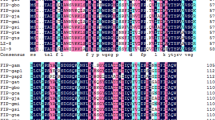Abstract
P53 is an attractive target in molecular cancer therapeutics because of its critical role in regulating cell cycle arrest and apoptosis. The limitations in the development of p53-based cancer therapeutic strategy include its inefficient transmission through cell membrane of tumor cells and low protein yields in the expression system. In the present study, p53 was fused with HIV TAT protein, which can cross cell membranes, and expressed by Pichia pastoris. Stable production of Tat-p53 was achieved. After being transduced with Tat-p53 protein, the growth of cancer cell line, HepG2, was inhibited by increased apoptosis in culture. This expression system could thus be utilized to produce human Tat-p53 fusion protein.





Similar content being viewed by others
References
Brooks H, Lebleu B, Vives E (2005) Tat peptide-mediated cellular delivery: back to basics. Adv Drug Deliv Rev 57:559–577
Feng MQ, Cai QS, Song DX, Dong JB, Zhou P (2006) High yield and secretion of recombinant human apolipoprotein AI in Pichia pastoris. Protein Expr Purif 46:337–342
Goh AM, Coffill CR, Lane DP (2011) The role of mutant p53 in human cancer. J Pathol 223(2):116–126
Gurkan C, Ellar DJ (2005) Recombinant production of bacterial toxins and their derivatives in the methylotrophic yeast Pichia pastoris. Microb Cell Fact 4:20–33
Jiang L, Ma L, Wang J, Tao X, Wei D (2008) The transduction of His-TAT-p53 fusion protein into the human osteogenic carcoma cell line (Saos-2) and its influence on cell cycle arrest and apoptosis. Mol Biol Rep 35:1–8
Macauley-Patrick S, Fazenda ML, McNeil B, Harvey LM (2005) Heterologous protein production using the Pichia pastoris expression system. Yeast 22(4):249–270
Moll UM, Wolff S, Speidel D, Deppert W (2005) Transcription independent pro-apoptotic functions of p53. Curr Opin Cell Biol 17(6):631–636
Patrick SM, Fazenda ML, Neil BM, Harvey LM (2005) Heterologous protein production using the Pichia pastoris expression system. Yeast 22:249–270
Ramón A, Marín M (2011) Advances in the production of membrane proteins in Pichia pastoris. Biotechnol J 6(6):700–706
Talos F, Petrenko O, Mena P (2005) Mitochondrially targeted p53 has tumor suppressor activities in vivo. Cancer Res 65(21):9971–9981
Vogelstein B, Lane DP, Levine AJ (2008) Surfing the p53 network. Nature 408(2000):307–310
Willis AC, Chen X (2002) The promise and obstacle of p53 as a cancer therapeutic agent. Curr Mol Med 2(4):329–345
Yoshida K, Miki Y (2010) The cell death machinery governed by the p53 tumor suppressor in response to DNA damage. Cancer Sci 101(4):831–835
Acknowledgments
This work was kindly supported by Shengyuan Biotechnology Co., Ltd., Changchun, P.R. China.
Author information
Authors and Affiliations
Corresponding author
Additional information
Haowei Yan and Nan Liu have contributed equally to this work.
Electronic supplementary material
Below is the link to the electronic supplementary material.
Rights and permissions
About this article
Cite this article
Yan, H., Liu, N., Zhao, Z. et al. Expression and purification of human TAT-p53 fusion protein in Pichia pastoris and its influence on HepG2 cell apoptosis. Biotechnol Lett 34, 1217–1223 (2012). https://doi.org/10.1007/s10529-012-0905-8
Received:
Accepted:
Published:
Issue Date:
DOI: https://doi.org/10.1007/s10529-012-0905-8




